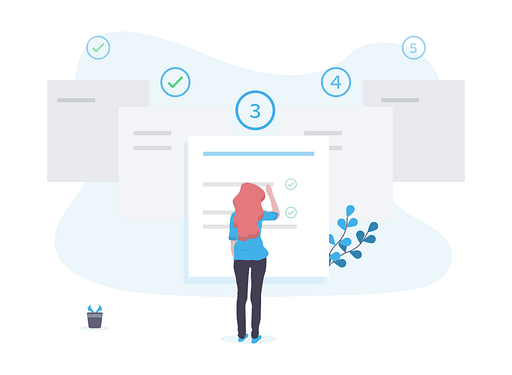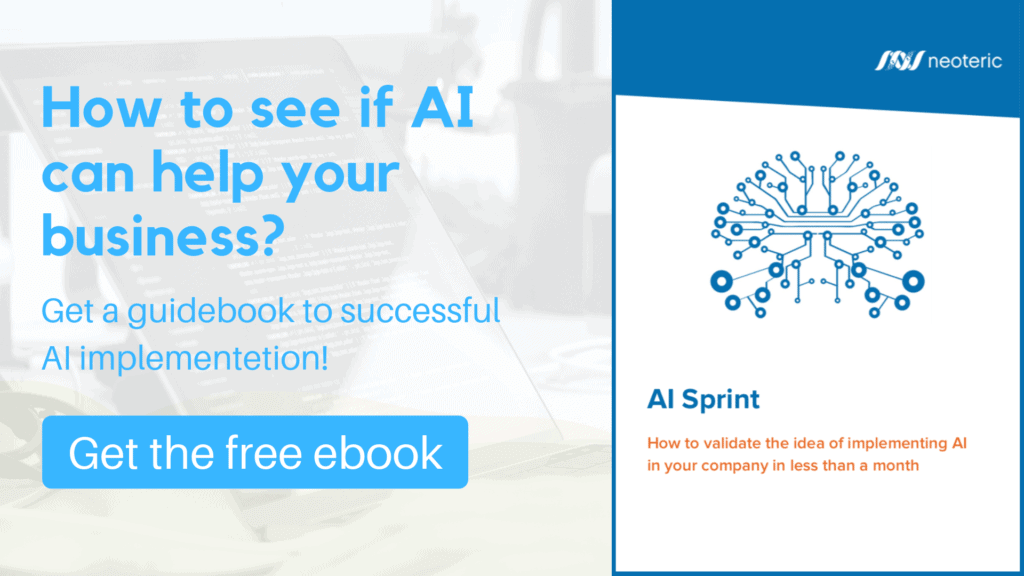It may be difficult to imagine artificial intelligence in education. It’s easier with other industries, but what has AI to do with education? Are we going to replace teachers with chatbots?
The worries about teachers losing their jobs are definitely premature – the fact is that humans understand humans, and the relationship students have with teachers is a part of the learning experience. However, AI can make education more accessible and individualized, allowing instructors to provide students with a more personalized approach and encouraging learners to continue education. Thanks to personalization and recommendations, the efficiency of learning can be improved and students’ satisfaction increased. Practices like that and the use of predictive analytics lead to reduced attrition and more revenue. Let’s look at some of the benefits AI presents for education.
Educational data mining
Educational data mining techniques track the behaviors of students, e.g. collecting the data on class attendance or assignment submission in order to identify the students who are at risk of leaving school. This way, those students can be given the support they need to stay on track with their education while educational institutions don’t lose students. Student retention can be a problem at many organizations, both online and offline. With the use of predictive analytics, the system can point the students likely to leave school.
Predictive analytics
Research shows that 40 to 80% of students drop out of online classes. When as many as 80% of students leave, what is the profitability of the course? Additionally, many learners give up their e-learning experiences in the first few weeks, which may be a problem for the company’s sales managers whose remuneration often relies on the student staying in the course for a given number of weeks or them making an upfront payment. Without proper retention rates, the sales team will not receive their commission.
A student’s decision to leave may be influenced by various social or motivational factors. It is, however, possible to predict the attrition rate, just like telecom companies can predict churn. The results of using predictive analytics to predict churn can be impressive: in one of our projects, we managed to reduce churn by 20%, saving the client $39k every month (and even more than that after rollout), ending up with more than 10x ROI. How could this be applied to an e-learning platform? Since the platform collects data about the students’ engagement and performance, this information can be analyzed to find patterns suggesting that a particular student is at risk of dropping out. This is an issue difficult to address in online courses, since direct contact between the educator and the students is limited (or, sometimes, non-existent). Predictive analytics can cut down on the dropout rate and identify the students who face academic or financial challenges so they can be provided with help.
Predictions can also be made about the markets that present good opportunities for investment. The e-learning industry is affected by a variety of factors related to the political and economic situation, as well as technology. The e-learning is a global business, expanding far beyond Europe where e-learning platforms compete not only with each other but also with traditional, public and private, educational organizations. Targeting markets such as Africa or the Middle East, companies have to be aware of many aspects influencing the students’ situation, which may seem quite unpredictable. Courses can lose accreditation, retention can drop unexpectedly, enrollment rates can decrease, students may struggle to continue paying tuition fees due to currency denomination. Issues like that are difficult to predict and manage, especially when you’re not prepared for such a sudden twist. With predictive analytics, however, you could see which markets are doing better than others and are worth investing in.

How artificial intelligence is changing teaching: personalized learning
Personalized education proves more successful than making everyone learn the same things. It allows for a better learning experience which is an important factor on the very competitive e-learning market. Truly personalized courses bring better results, so students’ motivation stays high, and they continue education. Personalized learning can be implemented into any type of course, be it improving professional skills, higher education, or self-development. Offer personalization is one of the factors that affect the customer’s decision to continue or abandon an online experience.
With AI, adaptive learning environments can further improve to offer an exceptional learning experience for all students. Adaptive learning environments are defined by Pearson as:
A digital learning environment that adapts teaching and learning approaches and materials to the capabilities and needs of individual learners.
Adaptive learning responds to the student’s needs, putting greater emphasis on certain topics, repeating things the students need to improve, and helping them learn at their own pace. Many students find bad pacing of online courses to be a problem and personalized learning solves this issue by adapting to the individual needs of a student.
Recommendation of resources
AI systems influence the way we see and interact with information. Based on historical data, Google shows us different search results, Amazon displays different products, Netflix recommends different movies. AI in education can analyze student data to suggest what they should learn. AI can recommend resources such as extra courses or materials much like Netflix recommends movies, making sure that the recommendations are relevant: based on individual needs, the current level of knowledge, and set goals. How do these recommendations matter to the business? Just like personalized learning, the recommendation system contributes to the student’s satisfaction with the course. Additionally, good recommendations may encourage customers to enroll in new courses. This, in turn, builds customer loyalty and increases revenue.
Automated grading
Grading consumes a large share of teachers’ time – and often it’s their free time that they have to dedicate to this task. Some sources estimate that teachers spend 36 minutes daily grading, other suggest that it can be even a few hours a day, especially if you want to do your job thoroughly and not just give the test/essay a grade but also add comments and suggestions for improvement. Artificial intelligence could be of help here.
While AI cannot fully replace humans in grading, it can now handle most of the multiple-choice and fill-in-the-blank tests. It’s also not far behind with checking students writing assignments. Essay-grading AI is still in its infancy, but we can easily use AI to automate test grading. This may not seem like a lot, but in reality, it’s a time-saver and that really matters. The time that AI frees up from the teachers’ schedule can be dedicated to contact with students and cut down on teachers’ overtime.
Improving courses
Educators may not always realize that they’re leaving some things unclear. There’s no ill will in that, the thing is that sometimes it’s easy to assume that something is “obvious”. For example, an English teacher who starts teaching an intermediate class will assume that the students already know how to use the past simple tense. And we all know that in reality, nothing really is that black and white and placement tests don’t do that great of a job. So what if a course is missing something? Research shows that there are discrepancies between how learners see e-learning before they enroll and how they actually experience it. They’re often unhappy with how much time and self-discipline is required. Not having previous experience with e-learning, they can get discouraged when they see their efforts not bringing the expected results, and they are more likely to resign from the course. In order to help students achieve their goals, educators have to make sure that their courses are well-designed and don’t leave any issues unexplained.
AI can help teachers improve their courses by pointing out the gaps in their lectures. As stated in a white paper Artificial intelligence to improve education, Coursera is already using a solution like that. When a large number of students submit the wrong answer to a homework assignment, the system notifies the teacher. Future students are offered hints to the correct answer. As written in the white paper:
This type of system helps to fill in the gaps in explanation that can occur in courses and helps to ensure that all students are building the same conceptual foundation. Rather than waiting to hear back from the professor, students get immediate feedback that helps them to understand a concept and remember how to do it correctly the next time around.

AI tutors
One-on-one tutoring has long been thought to be the most effective method of teaching and learning. It allows for a personalized approach where the educator can fully focus on the needs of the student. However, tutoring is not available to every single student who needs it. There simply aren’t enough tutors but also, it’s not an affordable solution to everyone. How can tutoring be made more accessible? It can be achieved with the help of Intelligent Tutoring Systems (ITS). As described by Pearson:
ITS use AI techniques to simulate one-to-one human tutoring, delivering learning activities best matched to a learner’s cognitive needs and providing targeted and timely feedback, all without an individual teacher having to be present.
ITS use machine learning techniques to determine the best content to provide to each student. AI tutoring systems are not very advanced just yet, but there are solutions that already allow students to take courses in basic mathematics or writing.
Feedback
Artificial intelligence makes sense of vast amounts of data to provide us with answers to the most troubling questions. With so many students in each class, teachers may often miss some signals indicating that a particular student has problems. Systems that monitor student progress can notify teachers whenever an issue with student performance occurs. The students themselves can also be given feedback, even in real-time. This is a very important factor because in traditional education students rarely understand how their learning happens. They would just say “I suck at physics”. Well, with AI-powered platforms, they can see where exactly they’re going wrong and receive advice to improve.
AI in education makes it possible for teachers to receive feedback on what topics to cover and what gaps to fill. As described above, the system can find issues in the courses to help educators improve them. There are also approaches that utilize face recognition to assess student engagement. Learner engagement has long been a problem to solve for educators. Tracking facial expressions of students allows capturing the emotions and reactions they express during the class. Information collected this way is more accurate than collecting information through surveys. Educators can then use the data to see how they can improve their courses efficiency by keeping the students engaged.
Real-time subtitles and translation
Artificial intelligence can make educational materials globally accessible even for students with hearing impairment or those who speak different languages. Students with hearing impairment will be able to participate in the lesson thanks to real-time subtitles. Same goes for students speaking other languages, who will be able to use real-time translation to know what the teacher is saying.
Can AI change the way we approach education?
AI for education can be used by schools and universities, both public and private, as well as businesses that want to provide their employees with guidance in terms of their professional development. Artificial intelligence can help teachers manage out-of-classroom tasks more efficiently, track their students’ individual progress, and provide the right type of support when it’s needed.
Artificial intelligence development services can help e-learning platforms improve the learners’ experience thanks to personalized learning and recommendations. Online students are struggling with issues such as low motivation, bad course pacing, unexpected requirements or poor communication with the instructor – all of these can affect a student’s decision to drop out of class. Using predictions of students who will drop out and providing high-quality, accessible, and individualized programs lead to higher satisfaction from the course and higher completion rates.

